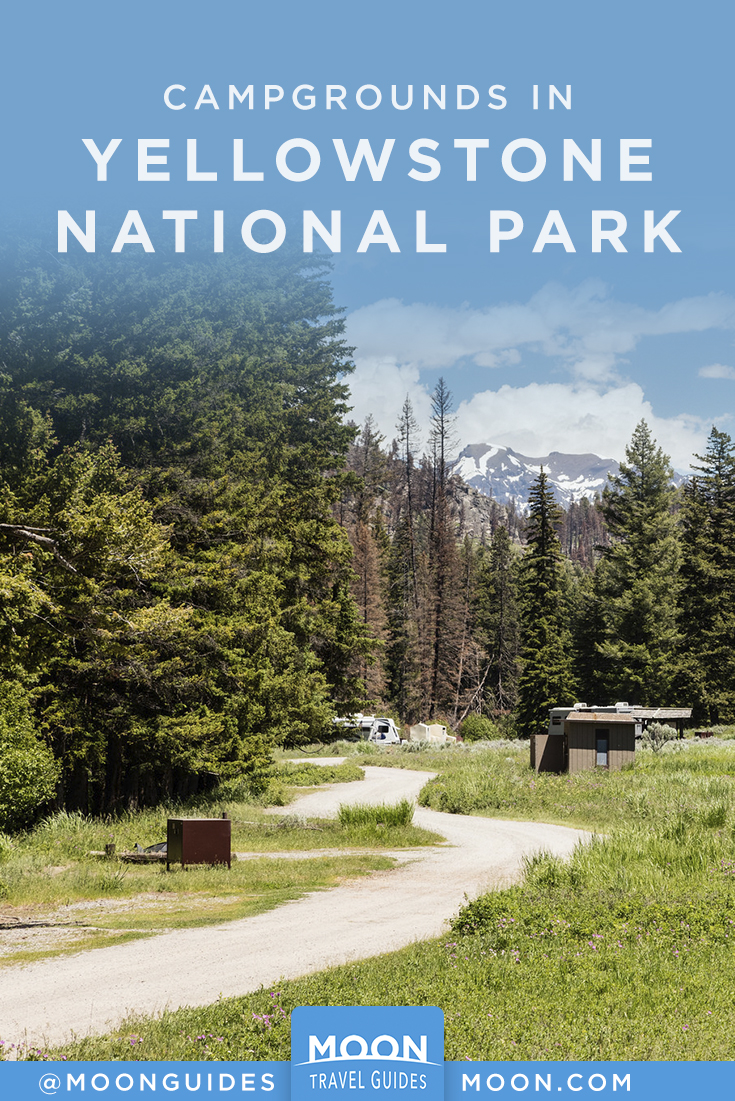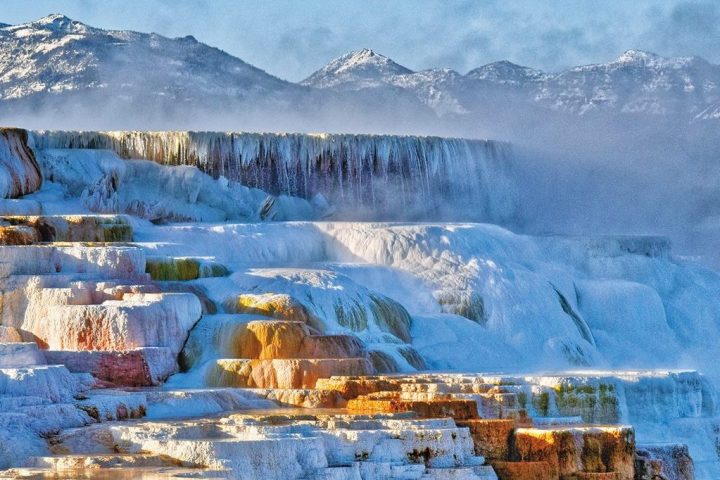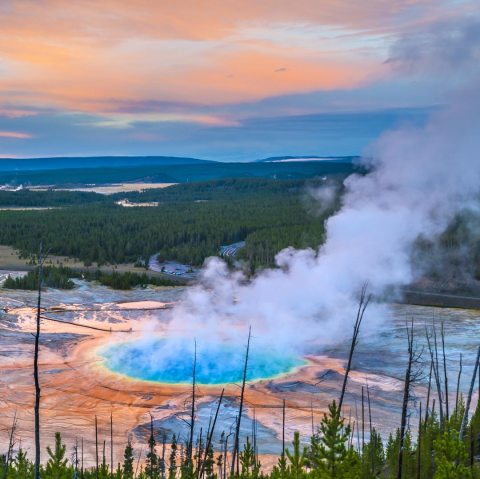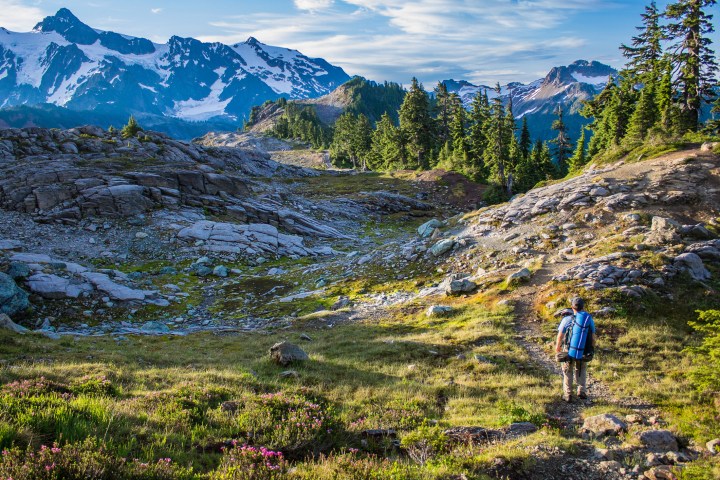Camping in Yellowstone National Park
Camping in Yellowstone National Park requires a bit of savvy. In summer, you cannot waltz in around sunset to claim a campsite. Campsites are filled up long before that.
In Yellowstone, you can make reservations (Xanterra, 307/344-7311 or 866/439-7375) for five campgrounds one year in advance. These are Fishing Bridge, Bridge Bay, Madison, Canyon, and Grant Village. Fishing Bridge, which allows only hard-sided rigs (no tent trailers), is the only one with hookups for RVs. Seven campgrounds in Yellowstone are first-come, first-served: Mammoth, Slough Creek, Pebble Creek, Indian Creek, Tower, Norris, and Lewis Lake.
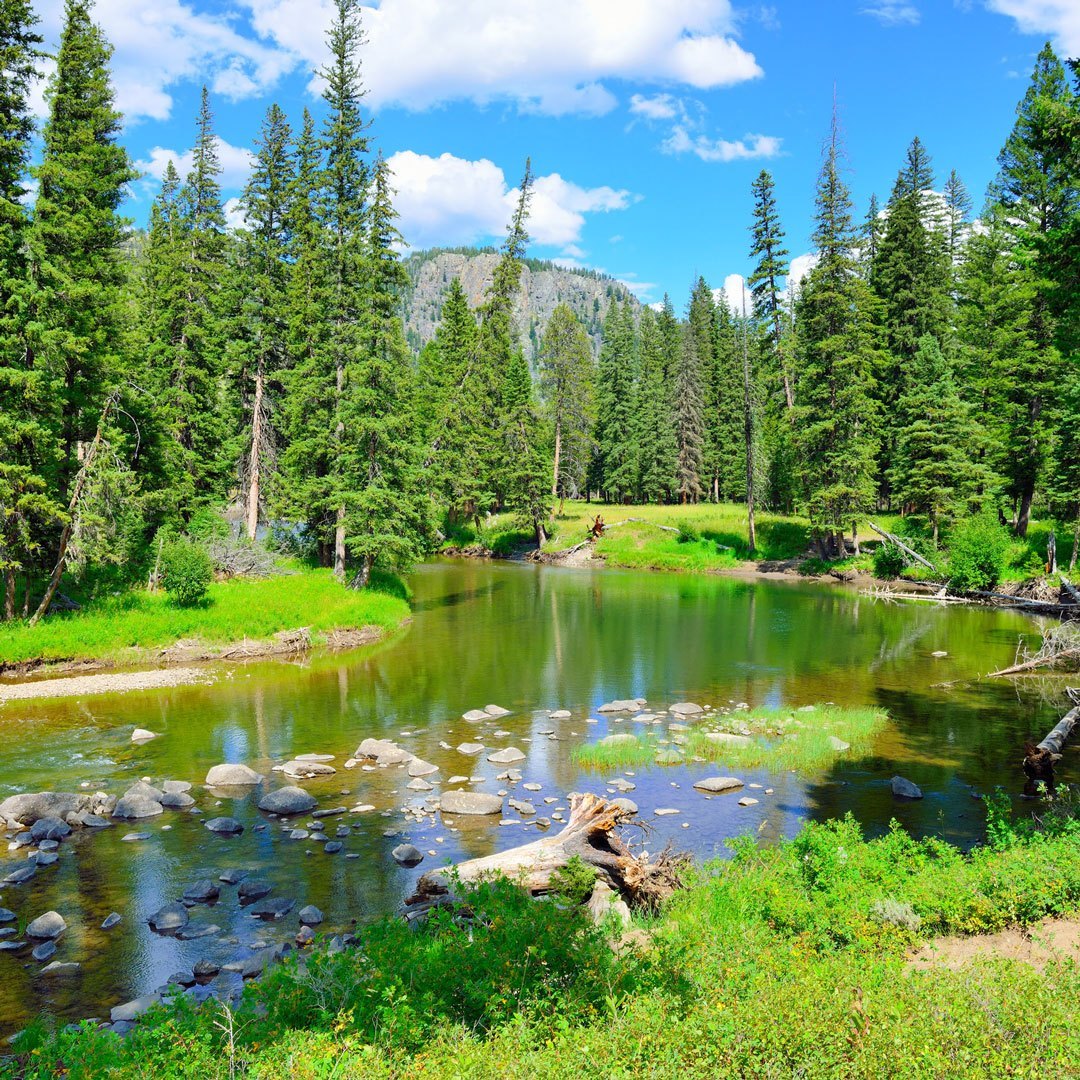
North Yellowstone
This region of Yellowstone has smaller campgrounds than elsewhere in the park. With the exception of Mammoth Campground, each offers a quiet place to get away from crowds. Reservations are not accepted; all campgrounds are first-come, first-served. Amenities include potable water, picnic tables, bear boxes for food storage, fire rings with grills, and flush or vault toilets, but no showers. Accessible sites are available at Mammoth and Indian Creek Campgrounds. Check online to see what time the campgrounds filled on the previous day and then aim to grab a campsite before then. In midsummer, campgrounds can fill before 8am.
Mammoth Hot Springs
At 6,200 feet, Mammoth Campground (year-round, $20) clusters its 85 campsites on an open sagebrush hillside with scattered trees. This is the only campground in the northern region of the park with flush toilets and where generators are permitted (8am-8pm). Most campsites have pull-through parking to accommodate RVs (some can fit combinations up to 75 feet), and 51 sites have tent pads. Campers can walk to trailheads, Mammoth Hot Springs Terraces, restaurants, and shops. Though it can be windy or hot in midsummer, most campsites get broad scenery of Gardner River Canyon. The access road to Mammoth Hot Springs circles the campground, which makes daytime traffic noise a factor. In winter, RVs are limited to 30 feet.
Mammoth to Norris
Eight miles south of Mammoth Hot Springs, Indian Creek Campground (mid-June-mid-Sept., $15) has 70 sites, vault toilets, and a quiet ambience with views of Electric Peak in the Gallatin Range. This is a place to hear the haunting hoot of owls or bugling elk in fall. Most campsites are tucked into the forest with parking pads (35 feet or less). At 7,300 feet, the campground offers quick access to Swan Lake Flat for wildlife-watching, the trailhead to Bighorn Pass, and Bunsen Peak.
Tower-Roosevelt
Set on a steep hillside above Tower Fall, Tower Fall Campground (late May-late Sept., $15) has 31 campsites with parking pads (30 feet or shorter), plus a hairpin turn to negotiate. Some sites sit in the open while others tuck under large pines. At 6,600 feet in elevation, hiking up or down the hill to vault toilets or to the hand-cranked water pump may have you huffing and puffing. A trail drops from the campground to the Tower Fall observation area, but be prepared to climb back uphill. Horseback trail rides and a restaurant are two miles north at Roosevelt Lodge. The amphitheater has evening naturalist talks.
Northeast Entrance
Slough Creek Campground (mid-June-early Sept., $15) is prized for its remoteness, solitude, wildlife-watching, and fishing. Lined up along Slough Creek at 6,250 feet in elevation, the 23 campsites vary from open sagebrush meadows to shady conifers. Prime campsites include creek frontage within sound of the water. All sites have less than 30-foot parking pads; amenities include hand pumps for water and vault toilets. This primitive campground is accessed via the dirt Slough Creek Road, five miles east of Tower Junction on the Northeast Entrance Road.
North of Lamar Valley at 6,900 feet elevation, Pebble Creek Campground (mid-June-late Sept., $15) loops through forest-flanked wildflower meadows. Some of the 27 campsites are open with views of the surrounding Absaroka Mountains, and a few are walk-in tent-only sites. Facilities include a hand pump for water and vault toilets. Nearby, you can access the trailhead to Trout Lake, fishing in Soda Butte Creek, wildlife-watching in Lamar Valley, or Silver Gate and Cooke City. The campground is located along the Northeast Entrance Road, 13 miles past Slough Creek Road.
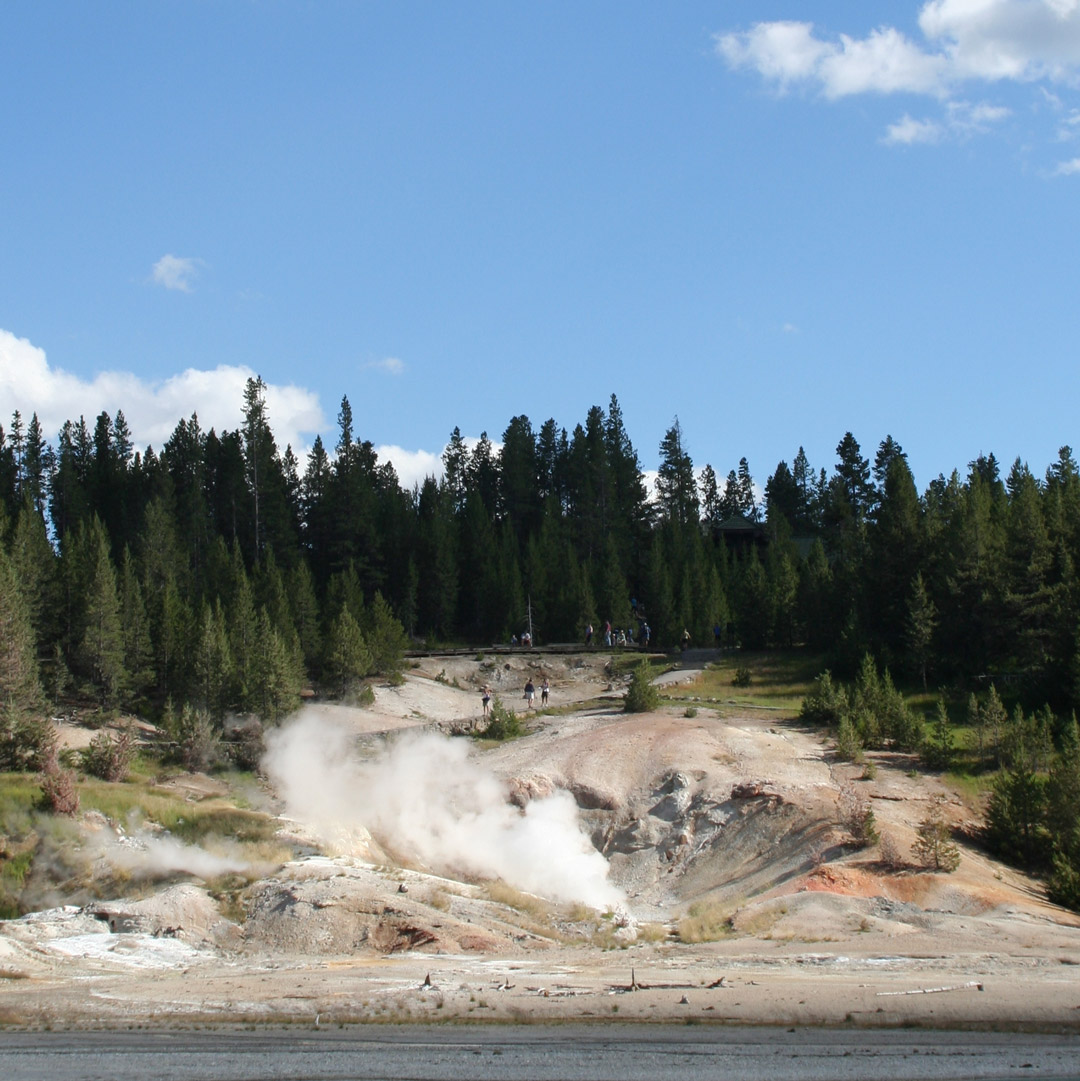
Old Faithful and West Yellowstone
Two outstanding campgrounds sit on Yellowstone’s west side. Madison is closest to Old Faithful, while Norris is closer to Mammoth and Canyon Village. Both campgrounds have flush toilets, potable water, picnic tables, fire rings with grills, food storage boxes, tent pads (at some sites), firewood and ice sales, evening ranger programs (mid-June-mid-Sept.), accessible sites, and shared biker-hiker campsites ($8/person). For hookups or showers, go to West Yellowstone.
Madison
At Madison Junction, below National Park Mountain, Madison Campground (307/344-7311 or 866/439-7375 advance reservations; 307/344-7901 same-day reservations, www.yellowstonenationalparklodges.com, May-mid-Oct., $25) has 278 sites on a flat plain spread around 10 loops. The Madison River flows past the campground, attracting anglers for iconic fly-fishing; wildlife-watchers often spot bison and elk. In fall, elk bugling fills the air. At the campground’s west end, G and H loops have 65 sunny sites for tents only. Some campsites can fit RVs up to 40 feet. Make reservations nine months in advance.
Norris
Across from Norris Geyser Basin at 7,555 feet on the Upper Grand Loop’s southwest corner, Norris Campground (first-come, first-served, mid-May-late Sept., $20) has 100 sites spread around a steep hillside. Loop A campsites are flatter and have views of surrounding meadows that often contain elk, bears, moose, or sandhill cranes. Bison often walk through campsites and bed down here. Prime walk-in tent sites line Solfatara Creek. The adjacent Museum of the National Park Ranger contains exhibits about early rangers, and nearby hiking trails lead to Norris Geyser Basin, Ice Lake, and north along Solfatara Creek. Arrive by 8am in summer to claim a campsite. RVs are limited to 30 feet.
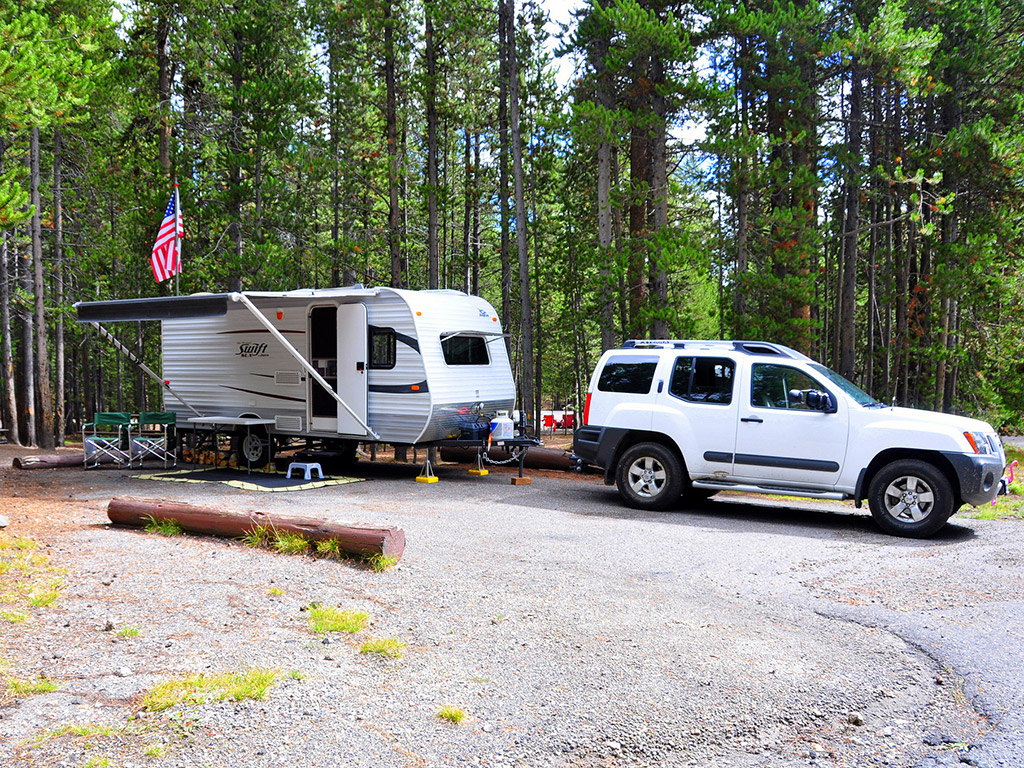
Canyon and Lake Country
Of the five campgrounds on the park’s east side, four accept reservations (Xanterra, 307/344-7311 or 866/439-7375). For summer, book reservations a year in advance at Canyon, Fishing Bridge, Bridge Bay, and Grant Village. Camping fees cover six people or one family; taxes and utility fees are added on. Call to pick up campsites from last minute cancellations.
Campgrounds have flush toilets, cold running water, potable water, coin-op ice machines, and evening amphitheater programs. With the exception of Fishing Bridge, they also have picnic tables, fire rings, firewood for sale, dishwashing stations, bear boxes, tent pads, and shared campsites for hikers and bikers ($8/person). For RVs, only a few campsites fit rigs or combos of 40 feet or more. The only campground with full hookups for RVs is Fishing Bridge. When searching for a campsite, check daily fill times online for status updates.
Canyon Village
Canyon Campground (late May-late Sept., $30) is one of the most-requested campgrounds due to its central location. On a hillside forest of conifers, the 270 campsites squeeze into tight quarters in a dozen loops at 7,944 feet. Some of the sites are sloped. Campsites are designated for RVs, tents, or RV and tent combos. Some pull-through and back-in sites can fit RVs up to 40 feet. The campground check-in building has pay showers (two per night included), coin-op laundry, and an RV dump station, although when temperatures freeze, it shuts down. Within 0.25 mile are stores, restaurants, Grand Canyon Visitor Education Center, a post office, and a gas station with repair service; Grand Canyon of the Yellowstone is one mile away.
Fishing Bridge
On the north end of Yellowstone Lake, Fishing Bridge RV Park (East Entrance Rd., early May-late Sept., $48) is the closest campground to the East Entrance Station. At 7,751 feet, it is the only campground in the park with electrical, water, and sewer hookups for RVs. All of the 340 sites are double-wide back-ins. If you don’t have huge slide-outs, you can fit a towed RV and a vehicle side by side. Hard-sided units are required; tents and pop-up tent trailers are not allowed. Surrounded by a forest, the campground stacks RVs close together like a parking lot, with a few pine trees separating some of the sites. Amenities include pay showers (two per night included), coin-op laundry, store, and an RV dump station. Nearby are a gas station with vehicle repair service, a general store that carries camping supplies and groceries, and the Fishing Bridge Museum and Visitor Center.
Lake Village
At 7,784 feet, Bridge Bay Campground (north of Bridge Bay Marina, mid-May-mid-Sept., $25) flanks a hillside across the road from Yellowstone Lake. With 432 campsites in 12 loops swooping through meadows and forests, the campground is the largest in the park. The five huge front loops sit on a large, sunny, sloped meadow with some views of the water, distant Absaroka Mountains, and neighboring campers. The meadows are green in June, brown in August. The back loops circle through conifers with more shady sites. Bridge Bay Marina has a boat launch, rentals, scenic cruises, store, RV dump station, and ranger station. Separate trails for bikers and hikers lead one mile to Natural Bridge, a rock arch above Bridge Creek.
Grant Village
Set in a lodgepole forest at 7,733 feet, Grant Village Campground (mid-June-mid-Sept., $30) sits on West Thumb Bay of Yellowstone Lake. A paved road with paved parking pads loops through this giant campground of 430 campsites with a midsummer population larger than some Wyoming towns. A lack of understory gives views of neighboring campers. Trails lead to a large pebble and sand beach for sunbathing or swimming in chilly water even in August. Local streams with spawning trout attract bears in spring, keeping the campground closed until mid-June. If bears are still hanging around spawning areas, nearby campground loops stay closed until bears dissipate. Within a half mile, Grant Village has stores, restaurants, pay showers, coin-op laundry, a visitors center, a post office, an RV dump station, and a marina that has cement boat launch ramps, docks, slips, and trailer parking. West Thumb Geyser Basin sits about three miles north of Grant Village. Of the lake campgrounds, this is the closest one to Old Faithful, 17 miles west over the Continental Divide.
Lewis Lake
Boaters, anglers, and paddlers favor the primitive first-come, first-served sites at Lewis Lake Campground (South Entrance Rd., 307/344-7381, mid-June-early Nov., $15). Located on Lewis Lake at 7,830 feet, this quiet campground is close to the South Entrance, hence it’s the first campground for those heading north from Grand Teton National Park and Jackson Hole. The campground flanks a forested hillside with 85 campsites and is one of the last in the park to fill; in peak season, all sites are claimed by 11am. RVs are limited to 25 feet, and generators are not allowed. The campground has vault toilets. When temperatures reach freezing, drinking water may be shut off. Paddlers can tour up the Lewis Channel to Shoshone Lake. Near the lake’s north end, trails lead to Shoshone Lake and Heart Lake. Lewis Falls sits one mile south.
By clicking ‘Sign Up,’ I acknowledge that I have read and agree to Hachette Book Group’s Privacy Policy and Terms of Use
Explore More of the Parks:
Pin it for Later
